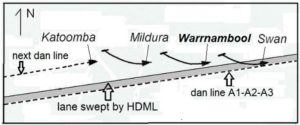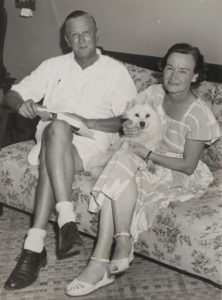- Author
- A.N. Other
- Subjects
- Biographies and personal histories, RAN operations, History - WW2
- Tags
-
- RAN Ships
- HMAS Swan II, HMAS Warrnambool II
- Publication
- September 2021 edition of the Naval Historical Review (all rights reserved)
By Hector Donohue and Mike Turner
Ross Wheatley was born in Adelaide on 19 December 1900, joined the Naval College in 1914 and subsequently specialised as a hydrographer, qualifying as a Charge Grade Surveyor in 1935.
The RAN 20th Minesweeping Flotilla (MSF 20) cleared mines in Australian waters from October 1940 to December 1941. Commander Wheatley was the CO of the Grimsby class sloop HMAS Warrego and Senior Officer MSF 20 (SO 20). He was promoted to Acting Captain during shore postings, and again became SO 20 when the flotilla was reactivated on 16 October 1945. Wheatley was now the CO of Warrego’s sister ship HMAS Swan. MSF 20 undertook mine clearance operations in Australian waters in 1945 and 1946, Kavieng and Rabaul in 1946, and Port Moresby in 1946. An assessment of Wheatley by the Flag Officer in Charge East Australian Area, A/RADM H. A. Showers CBE, RAN included ‘A very able and experienced officer possessing sound judgement and initiative’.
HMAS Bungaree laid 38 minefields along the Great Barrier Reef. MSF 20, still under Wheatley in Swan, was given the task of clearing these minefields, and commenced in February 1947. The lack of clear features on the reef presented both Bungaree and MSF 20 with serious navigation problems. The clearance of minefield HOME began on 13 September. Harbour Defence Motor Launch (HDML) 1329 was to lay initial dan buoys A1, A2 and A3 outside the mine line for the flotilla to work towards the mine line. However numerous pinnacles forced HDML 1329 to lay the initial dan line across the mine line with dan buoy A2 on the mine line.
HDML 1329 had a draught of only 1.7 m and was tasked with precursor sweeping to 13 m for a 110 m wide lane to provide Swan with clear water for her first run as guide. The initial precursor run commenced at about 1200 and the tidal set was easterly. The run was aborted when the sweep parted on a pinnacle. A second precursor run to 8.2 m at about 1415 was a clear run. The tidal set was now north westerly.
Clearance sweeping was by HMA Ships Swan, Warrnambool and Mildura with port Oropesa sweeps and HMAS Katoomba as danlayer. The tidal set was now westerly and this was given due consideration. All three sweeps parted on pinnacles and the four minesweepers ran along the dan line. Warrnambool was near dan buoy A3 when she hit a mine at 1556. She sank with four fatalities, and injuries to three officers and 26 sailors. Dan buoys had swung on their watch circle around their sinker, and the dan line had moved about 20 m south into unswept water since the second precursor run.

The original Board of Inquiry into the sinking of Warrnambool began on 22 September 1947. Confusing the clear precursor run with north westerly tidal set with the earlier aborted precursor run with easterly tidal set, the board was unfairly critical of Wheatley, stating: ‘…the plan of the Senior Officer, 20th Minesweeping Flotilla, for Operation KILHOME was not entirely sound. In that consideration was not given to the reversal [authors’ emphasis] in the direction of the tidal stream, and this factor was the probable cause of the sinking of WARRNAMBOOL’.
The Naval Board was uneasy about the findings of the original Board of Inquiry and ordered a second Board of Inquiry, held on 30 December, 1947 with only seven critical questions. Wheatley was completely exonerated. A report by the Chief of Naval Staff, Vice Admiral John Collins RAN, included:
‘Captain Wheatley took all prudent and reasonable acts to ensure the safety of the ships under his Command’ and: ‘The successful conclusion of the programme of mine clearance off the Queensland coast reflects the greatest credit on Captain Wheatley’.
The Minister for the Navy (Mr Riordon) commenting on 30 October 1947 into an inquiry into the loss of Warrnambool said: ‘Nobody was to blame for this disaster in so far as they were negligent’, and that ‘Every-precaution was taken, but these accidents will happen. The fact that there have been no other serious accidents indicates that every precaution is taken. There is no question that Acting Commander Allan J. Travis [CO HMAS Warrnambool] displayed great seamanship and that the conduct of the crew was most exemplary and in keeping with the best traditions of the RAN’.
Sweeping these minefields was completed in October 1947, about 1600 mines having been swept by eleven minesweepers. Wheatley was awarded an OBE on 8 June 1950 in the post war honours list, and retired as an acting captain on 21 December 1953. He died on 26 May 1966

References
Turner, Mike and Donohue, Hector, Australian Minesweepers at War, Sea Power Centre-Australia, Canberra, 2018.
Wheatley service records, NAA A6769.
Warrnambool Inquiry Clears Captain and Crew, The Canberra Times, 30 October 1947.




